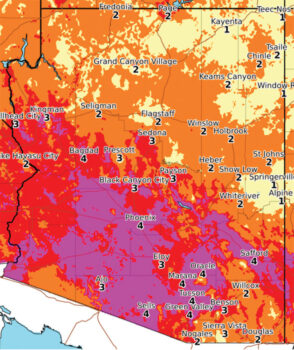 Marilu Trainor
Marilu Trainor
Predicting the weather is not a guessing game. The job of saving lives and property is taken very seriously by forecasters and is included in the mission statement of the National Weather Service. The government’s meteorologists use multiple sophisticated systems to help them help us stay safe and to know what to expect for our day or week ahead in the weather arena.
When it comes to heat, local knowledge and climate histories help them refine those forecasts.
“At NWS Phoenix, as well as other offices throughout the West, we use a product called HeatRisk, which adjusts to the annual climate of an individual location rather than using fixed individual values, to help with the decision process,” said Sean Benedict, NWS Forecast Office, Phoenix.
“HeatRisk is based on forecast high and low temperatures and will assign a numeric value (0-4) and color (green, yellow, orange, red, and magenta) to every point location across the region.
“We will issue Excessive Heat Watches/Warnings and Heat Advisories when excessive heat is expected that could lead to significant heat-related health impacts,” said Benedict.
The NWS HeatRisk forecast provides a quick view of heat risk potential over the upcoming seven days. This product is supplementary to the official NWS heat watch/warning/advisory program.
“Typically, we issue Excessive Heat Watches/Warnings and Heat Advisories when HeatRisk reaches high (red) or very high (magenta). This can happen with highs around 105 in the spring or fall or with highs near 115 during the heart of the summer. However, special occasions are occasionally made for high-end moderate HeatRisk events if they are widespread during the early heat season (i.e., spring) or occur during a significant outdoor event or holiday,” said Benedict.
In the NWS Western Region, the HeatRisk product is used as the primary decision tool for issuing heat products, whereas the heat index is more commonly used in the other regions. The NWS Western Region is made up of Arizona, Nevada, California, Utah, Oregon, Washington, Idaho, and Montana and is headquartered in Salt Lake City.
“Our Western region is mostly a drier climate that doesn’t typically see high heat indices, but that doesn’t mean it cannot happen,” said Benedict. “Relative humidity in the Phoenix area is typically in the 15-35% range during the summer. Again, we will typically issue heat products for high (red) or very high (magenta) HeatRisk.”
